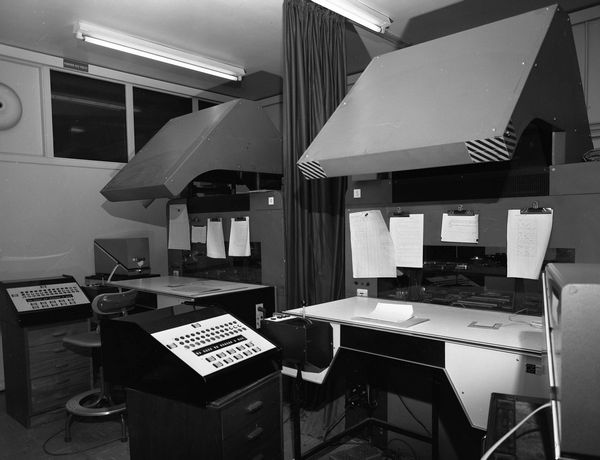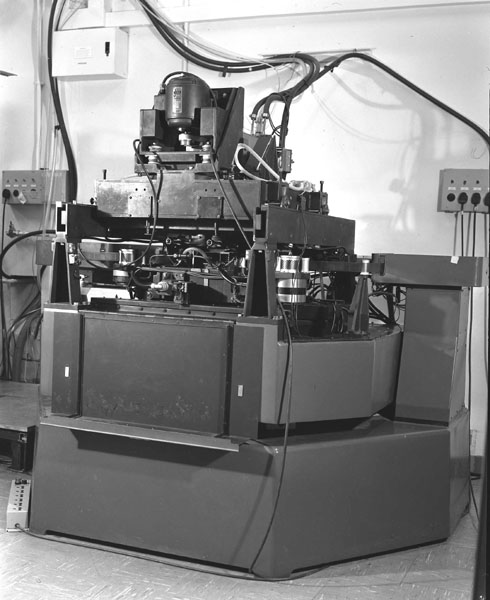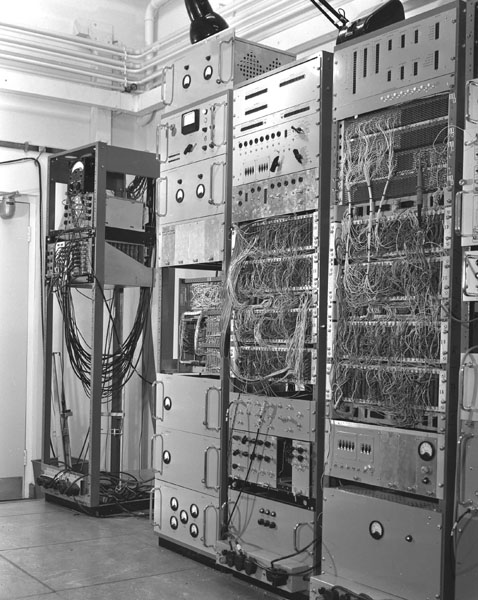

During 1966 the Laboratory continued to rely on the Cbilton Atlas for the bulk of its on-line computing; some use continued to be made of the Imperial College IBM 7090 and the Glasgow University IBM 7044. Orion was used mainly for the reception (via the DDP-224) of data from on-line experiments am measuring devices. Some experimental groups used small local computers for real-time surveillance of experiments. Orion was dismantled In September and an IBM System/360 Model 75 was installed in December.
The coupled System Orion/DDP continued to be used mainly for controlling the HPD flying-spot digitiser by means of a program in Orion, data being collected by the DDP; during the same time the DDP was being used as a data collector and analyser by the CRT film scanner and a physics experiment (P3 or K6). Several versions were made of the DDP program which managed this multiple activity.
Like Orion, IBM System/360 Model 75 will use the DDP as an on-line data collector and disseminator but the real-time monitoring programs will reside in the System/360, together with one or more non-real-time problem programs. Much of the controlling programs to connect the 75 to the DDP were written during the year; testing began before the end of December.
Much study was given to the supervisory software supplied by IBM with the 75 so that the change over from Atlas to the Laboratory's own computer during the early months of 1967 should be as painless as possible.
Orion was removed in September so that the computer room and associated areas could be modified for the new computer. Parts of the machine were sent the Chilton Atlas and parts to the Rothamsted Experimental station of the Agricultural Research Council so that their Orion could be brought up to the size necessary to exploit the Fortran Operating System developed at the Rutherford Laboratory.
The four manual measuring machines are now operating satisfactorily and reliably produce over 500 events each week compared with 300 events before the improvement programme was started. These machines have now been handed over to Central Engineering Group for regular maintenance.
Four scanning tables are now equipped with rough digitisers and are operating satisfactorily. Two further scanning tables are being modified to give larger projected images and will then be fitted with larger rough digitisers. A further machine will be installed shortly.

All the scanning and rough digitising equipment has now been installed in a spacious new scanning laboratory in which special attention has been given to the environmental conditions. The laboratory is equipped with air conditioning and subdued lighting and the overall conditions are much improved. Similar attention is now being given to the environment of the measuring machines.
Plans are being made to attach these machines on-line to a computer.
The DDP-224 computer is now maintained by the group and its performance during the past 6 months has been very good.
A complex data link has been designed and constructed to connect the DDP-224 to the IBM 360/75 central computer. This is now fully installed and working.
The first half of the year was spent in attempting to operate a production HPD system for measurement of the eta decay experiment. The short-comings of the HPD machine and to a lesser extent difficulties with the Orion computer severely limited the amount of useful work that could be done. Nevertheless, it was possible to gain operational experience with the system and to help train the newly acquired staff. During this period the problems of operations and maintenance became clearer as did the technical limitations of HPD. As the Orion computer was to be replaced by an IBM 360/75 in November a decision was taken to rebuild large sections of the HPD. Operations were therefore terminated in early September 1966.


The second half of the year was spent in rebuilding the HPD mechanics and electronics with a view to increasing the reliability, speed and precision of the machine. Assistance from the Central Engineering Group in the mechanical and general electrical aspects of the machine enabled the HPD group to concentrate on the optical and electronic design. A great deal of work was done over a two-month period and towards the end of the year recommissioning of HPD 1 was started. The latest results from acceptance testing have indicated that the reliability and operation of the machine have been greatly improved.
The latest work on the electronics of the machine has been in the field of high speed memory systems using the latest integrated circuit techniques for speeds up to 30 Mc/s. This equipment has recently been installed on the machine and is undergoing computer tests. This work and the general recommissioning has utilized a DDP-224 computer using programs developed in collaboration with the Theoretical Studies Group. It has also been necessary to become involved in the overall diagnostic programs for the full operating system.
Also during this latter period we have collaborated with the Central Engineering Group and Sogenique, Newport Pagnell, in producing a version of the mechanics known as HPD Mk 2a (our HPD 2). This was delivered to the Group in January 1967.
The CRT film scanner Cyclops continued to operate during 1966, measuring film from the K0 2 - 2 π0 experiment. The scanner and computer system has worked with 80% reliability and a batch of 30,000 events was measured in a continuous seven-week period. The machine maintained its accuracy of ±3 μ over long periods of time and measured events can safely be stored on magnetic tape and processed at a later time on the Atlas computer. Processing on the Atlas computer continued regularly throughout the year.
The scanner control programs in the DDP-224 are being developed to study the possibilities of diagnosing faults in the scanner and data being sent to the computer. A program is also being developed to use a large CRT display and light pen to rescue the events which are rejected by the Atlas programs.
Programs are also being written to control the scanner from the IBM 360/75 and to process the events on the same computer. When the new computer configuration is complete a start will be made to measure two further spark chamber experiments.